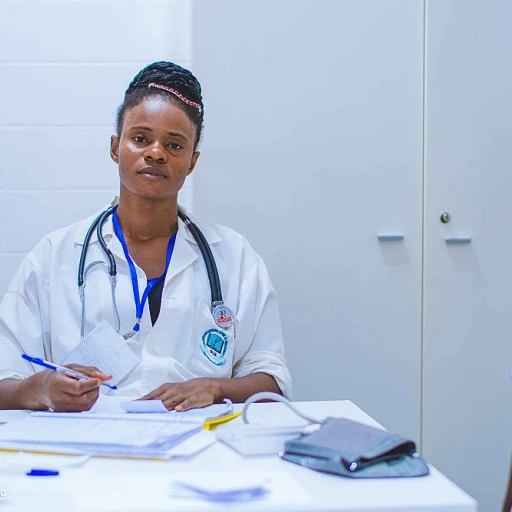
Understanding the Innovation Drive
In today's ever-evolving landscape, innovation acts as a powerful driving force, pushing industries to adapt and thrive. Whether in the bustling streets of Redwood City or amid the tranquil settings of an innovation park in Milwaukee County, continuous learning serves as the backbone for fostering this change. By understanding the core necessity of innovation, organizations are better equipped to stay competitive and relevant.
Recognizing the Innovation Drive in Industries
Across various sectors such as healthcare, manufacturing, and community services, the need for innovation is indispensable. Take the medical industry, for example. With constant advancements in medical devices and care practices, health centers need to continuously integrate new technologies and methodologies. Consider a modern facility equipped with state-of-the-art manufacturing equipment or a fitness center that offers cutting-edge patient care services. These locations are continuously evolving, ensuring that both patients and care providers benefit from the latest advancements.
Looking at the manufacturing sector, companies are increasingly focusing on reducing downtime and improving efficiency with next-gen equipment. From adopting innovative drive systems to installing more efficient charging stations within their facilities, the intention is always to enhance productivity and quality. Furthermore, creating adaptable workspaces, like conference rooms equipped for diverse functions, contributes significantly to the innovative drive and enhances collaborative efforts.
In community services, building a space that embraces change is crucial. Being situated in strategic locations like center innovations in Reno, Nevada, allows these services to offer diverse pathways and drive directions for continuous improvement.
The Importance of, and Barriers to, Innovation
Establishing an innovative community springs from an understanding of the intrinsic need for evolution and improvement. Yet, several barriers may impede this journey. Addressing these challenges head-on with effective strategies can ensure a thriving environment conducive to growth. For instance, facilitating a dynamic learning culture helps organizations adapt to technological changes and effectively address any potential roadblocks. Understanding and leveraging the innovation drive leads to the development of more resilient systems across industries.
For those eager to delve deeper into "innovative strategies for leadership in continuous learning," exploring diverse methodologies and leadership approaches can be crucial to fostering an environment where innovation is not only encouraged but flourishes.
The Role of Curiosity in Learning
Exploring the Role of Inquisitiveness in Continuous Learning
Curiosity is a driving force behind innovation. It's the spark that ignites a relentless quest for knowledge and understanding. In an era marked by rapid technological advancements, nurturing an insatiable curiosity among professionals is a cornerstone of maintaining an innovative edge. Businesses, from health care centers to manufacturing units, rely on curiosity-driven strategies to propel their innovation drive. Continuous learning fueled by curiosity is essential for both individuals and organizations. In the healthcare industry, for instance, caregivers and medical equipment manufacturers are consistently exploring better ways to enhance patient care. The drive innovation in health services stems from a community-centric approach that prioritizes patient needs and leverages the latest advancements in medical technology. Manufacturing sectors are not left behind. In locations like Reno, Nevada, and Redwood City, centers of innovation are booming as companies adapt to new manufacturing equipment to meet changing market demands. These innovative strategies often involve assessing the different approaches to boost production efficiency and adapt to new trends swiftly. For businesses and communities aiming for growth, curiosity should permeate every level. From charging stations in modern conference rooms to fitness centers that embrace the latest health trends, a curiosity-driven culture cultivates a sustainable environment for innovation. With curiosity at the helm, spaces designed for open learning and exchange—like innovation parks and county parks—become vital. These spaces are central to bringing together diverse views and fostering a collaborative culture. In the United States, initiatives aimed at nurturing curiosity and continuous learning are gaining traction. By creating environments where questions are encouraged and explorations into various knowledge domains can occur, companies can ensure they remain at the forefront of innovation. This ensures that they not only meet current needs but are also prepared for future challenges. Diverse knowledge domains provide a fertile ground for new ideas. Building on this energetic curiosity facilitates overcoming barriers and reaping the numerous benefits continuous learning offers across sectors.Adapting to Technological Changes
Embracing Technological Advancements
In today’s fast-paced world, technological changes are as constant as they are significant. As industries like health care and manufacturing strive to stay ahead, organizations across spaces from innovation parks in Reno, Nevada, to medical device production in major centers are at the forefront of adaptation. The innovative drive is not just a preference—it is a necessity. The rapid evolution in fields like manufacturing equipment and medical devices demands continual updates in knowledge and skills from care providers and engineers alike. This need becomes especially clear when you consider the expectations of patients, both in terms of medical care and the broader experience involving services like fitness centers and cafe proximities. It is no longer sufficient to merely possess the knowledge acquired several years ago; the dynamic landscape requires ongoing education to meet new challenges and opportunities. Organizations, particularly those in the United States, are responding by integrating continuous learning into their core strategies. Community centers, such as those in Redwood City and Milwaukee County, frequently offer workshops and seminars aimed at equipping their workforce with the latest techniques and information. From navigating innovative directions in medical care to engaging in fitness and health at a center innovation, these initiatives are sparking a culture shift. Moreover, adapting to new technology often starts with providing the right infrastructure. Constructing the proper foundation, whether it involves adapting conference rooms to facilitate hybrid learning or installing charging stations for high-tech devices, lays the groundwork for greater learning outcomes. Through these proactive measures, industries contribute significantly to the creation of an innovation drive that propels them forward. To truly embrace change, however, organizations must encourage a learning view that extends beyond immediate gains. By fostering an environment where trial, error, and repetition are seen as learning cornerstones, they lay the groundwork for continual growth. This approach resonates deeply with the evolving needs of patients and visitors who demand services that are conscious of the latest advancements and trends. For those intrigued by the intersection of workforce adaptability and technological change, the role of curiosity in mastering life skills through repetition offers further insights (Mastering Life Skills Through the Power of Repetition). By continually pushing boundaries and encouraging professional development, organizations ensure that they are not left behind by rapid technological advancement. The impact is a robust and eager workforce that drives innovation and meets the ever-evolving demands of their respective fields, from patient care in medical facilities to dynamic production lines equipped with the latest technology.Building a Culture of Learning
Encouraging a Lifelong Learning Environment
Fostering a culture of learning within any organization or community is essential to drive innovation efficiently. Whether it's a medical care center, a manufacturing space, or a tech-driven center, the goal remains the same: to ensure innovation is continuously nurtured. It's important to align the drive for knowledge and skill acquisition with the organization’s innovation objectives. Creating an environment that encourages continuous learning requires a multifaceted approach:- Dedicated Spaces for Learning: Establishing areas such as conference rooms, cafes, and even outdoor spaces like those found in any county park can provide conducive environments for learning. Equipping these spaces with the necessary resources, like charging stations for medical devices or other manufacturing equipment, makes learning more accessible.
- Comprehensive Training Programs: Tailored programs in fitness centers or medical devices training ensure that both staff and visitors, including patients, have access to updated knowledge and skills. This aligns with the innovative drive seen in places like Reno, Nevada, and Redwood City, where innovative directions are continuously pursued.
- Involvement of the Community: Encouraging interaction within the community helps to build networks and share knowledge. This bridges the gap between care providers and patients, enhancing the quality of care and innovation.
- Leveraging Technology: Technological advancements play a critical role in the continuous learning environment. Utilizing innovative tools in locations like Innovation Park, as seen in Milwaukee County, helps streamline the learning process and equips learners with modern skills.
- Inculcating Curiosity and Open-mindedness: Supporting a culture where curiosity is encouraged ensures that individuals remain open to learning and adapting, which is crucial for overcoming challenges presented by rapid technological changes.












